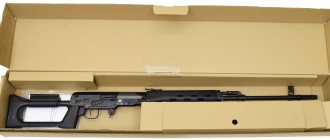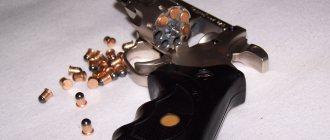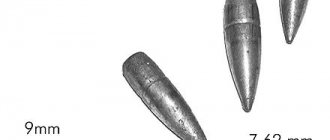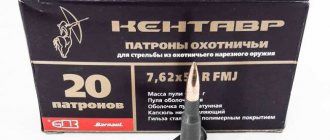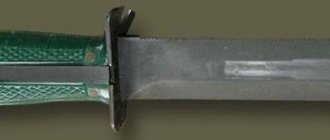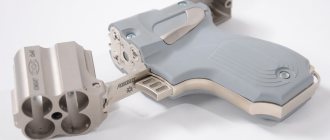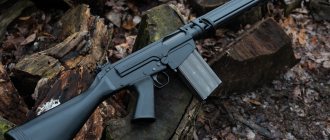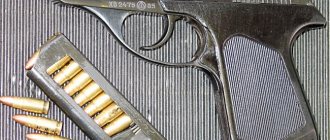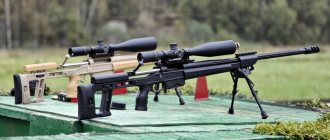Armament
We offer an overview of the main rifle and machine gun ammunition, and also consider two key characteristics of the cartridge: lethality and stopping effect.
Lethality and stopping effect.
There is no strict definition of these terms, however, lethality is usually understood as the ability to inflict wounds incompatible with life, and stopping action is the ability to inflict such a blow on the target that it “almost instantly (within 1-2 seconds, no more ) will stop performing the actions that she was performing at the moment of the shot” (D. Towert).
At the same time, the lethal effect and the stopping effect may not be directly related: for example, a 37mm Flashball gun, which shoots rubber bullet balls, has a significant stopping effect on a person, but practically no lethal effect. And the 5.6x39mm MBO cartridge has a high lethal effect when shooting at medium and even large game (with an accurate hit), but death in the case of animals such as elk or wild boar will occur in minutes or even tens of minutes.
When hunting, stopping action is most important, regardless of whether you are hunting a hare, goose, elk or rhinoceros. High stopping power will ensure the absence of wounded wounds and loss of game even if you were unable to kill the game with the first shot - you will have the opportunity to shoot again while the target is knocked out. The same applies to ammunition intended for self-defense and police purposes.
For military ammunition, no matter how cynical it may sound, the lethal effect, or more precisely, the ability to inflict severe wounds, is more important than the stopping effect. This is explained by the fact that, from the point of view of military strategy, a wounded enemy is more profitable than a killed one: it takes much more effort and resources (for evacuation from the battlefield, for treatment), plus, the sight of comrades suffering from wounds has a demoralizing effect on soldiers, while the sight of the dead would rather call for vengeance. These considerations apparently explain to some extent the appearance of such cartridges with low-resistant or disintegrating bullets that cause severe wounds, such as the Soviet 5.45x39mm or the American 5.56mm NATO.
To determine the adequacy of the lethal effect, there is the following empirical relationship: the bullet energy in Joules must be at least 8-10 times the target’s body weight in kilograms, that is, to kill an animal weighing 50 kg, it is desirable that the bullet have energy at the moment of impact not I think it's 400 Joules. To determine the stopping effect, such simple dependencies do not exist, however, with equal kinetic energy at the moment of impact, which quantitatively satisfies the above requirement for lethality, bullets of a larger caliber will have the greatest stopping effect, or bullets that increase their diameter upon impact (expansive), or high-speed ones ( at a speed of about 1000 or more meters per second) small-caliber bullets that cause the main damage with a supersonic shock wave arising in the target’s body.
Thus, a round hunting bullet weighing 30g, fired from a 12-gauge smoothbore shotgun with a speed of 380 m/s and a sharp-nosed jacket bullet of a 7.62x39mm live cartridge weighing 7.9 grams with an initial speed of 730 m/s will have almost the same muzzle energy of 2000-2100 Joules, but the stopping effect of a 12 gauge bullet will be incomparably greater. This explains the fact that going after a boar or even a bear with a 12-caliber smooth-bore gun is quite common, but with a weapon of 7.62x39mm caliber, even with an automatic weapon like the AKM, either a person who has no other choice or, to put it mildly, will go after a bear. let's say not too smart.
Small caliber cartridges.
.22LR (5.6mm rimfire)
The .22LR cartridge was introduced around 1887 by the J. Stevens Arm & Tool Company and undisputedly holds the world record for the most cartridges fired (and fired). Currently, this cartridge is one of the very few (in fact, only three) remaining popular rimfire cartridges (that is, the cartridge does not have a primer as a separate part, and the initiating substance is located along the ring in the rim of the case - hence the name).
The most common training and sporting ammunition, .22LR is also a popular hunting ammunition: in Russia it is used to hunt small fur-bearing animals, in the USA it is used to shoot small rodents (gophers, etc.). Countless samples of long-barreled weapons (not counting pistols and revolvers) have been produced under this cartridge - single- and multi-shot rifles with a wide variety of reloading schemes, self-loading rifles (carbines), and even fully automatic samples, such as the American All-American 180 submachine gun, having a disk magazine for 176 or 220 (!) .22LR cartridges, placed on top of the receiver (similar to Lewis or DP-27 light machine guns).
Cartridge performance characteristics:
nominal caliber: 5.6 mm bullet diameter: 5.66 mm bullet weight: 2.72 g gunpowder weight: 0.34 g V0: 346 m/s E0: 132 J
5.45x39mm
This cartridge owes its birth to the success of the American program to rearm its army with weapons chambered for a small-caliber cartridge (5.56x45mm NATO). As a result, in the mid-1970s, the Soviet Army adopted a small arms complex consisting of a cartridge, an AK-74 assault rifle (AKS-74) and an RPK-74 light machine gun. Later, the shortened AKS-74U assault rifle joined this family. Currently, the assessment of this step (the transition from 7.62mm caliber to 5.45mm caliber) is quite ambiguous. On the one hand, there is a common myth about the “offset running deer” bullet, but it is not suitable for hunting weapons due to the increased maximum pressure in the barrel. The main types of weapons chambered for this cartridge are Bars hunting carbines with a sliding bolt. Recently, IzhMash has been producing the Saiga-5.6 self-loading carbine chambered for this cartridge. In the United States, based on this ammunition, called .22 Russian, they created two of their own ammunition for hunting and target shooting - .22 RRS and 6mm RRS. Being built on the same cartridge case from the 7.62x39mm cartridge, they have bullets of 5.56mm (.224) and 6mm calibers, respectively. In terms of their characteristics, both 5.6x39mm and .22 RRS are noticeably superior to the widely used .223 Remington ammunition.
Cartridge performance characteristics (hunting):
nominal caliber: 5.6 mm bullet diameter: 5.6 mm bullet weight: 2.8 or 3.5 g V0: 1200 or 1000 m/s E0: 2020 or 1750 J
5.56x45mm (5.56mm NATO, .223 Remington)
By the mid-1950s, it became clear that the 7.62mm NATO cartridge could not provide the ability to conduct aimed automatic fire from small arms. The US Army decided to switch to a smaller caliber cartridge - 5.56mm (nominally designated according to the American system .22, .221, .222, .223 or .224 - in fact, the bullet diameter is the same for all given designations). Three cartridges participated in the competition: .222 Winchester, .224 Springfield, and .222 Special. The latter was developed with the participation of Eugene Stoner, then working at the American company Aramalite. All three cartridges were long variations of the .222 Remington hunting cartridge (5.56x42mm). The winner of the competition for both cartridge and weapon was Stoner's creations - a cartridge later called .223 Remington, and an AR-15 assault rifle - a modification of Stoner's AR-10 rifle chambered for 7.62mm NATO. In 1964, the US Army officially adopted the .223 Remington cartridge under the designation M193 and the AR-15 rifle under the designation M16.
In the 80s in Belgium, Fabrique Nationale developed a new version of this cartridge with a heavier bullet under the designation SS109 (originally developed for the FN FNC assault rifle and the FN Minimi light machine gun). By the mid-80s, this cartridge, which differed from the M193 in a heavier bullet designed for a smaller rifling pitch (178mm instead of 305mm for the M193), was adopted as standard for all NATO countries. In the USA, the SS109 was adopted for service under the designation M855 and a new modification of the M16 rifle, the M16A2, with a heavier barrel with a modified rifling pitch, was adopted for service under it. Old cartridges can also be used in weapons under the M855, just as the M855 can be used in the old M16A1, but shooting accuracy will deteriorate.
In addition to military use, the .223 Remington turned out to be an excellent cartridge for hunting rodents and small predators, roe deer weighing up to 30-50 kg at distances of up to 200-250 meters, and currently the widest range of hunting ammunition and weapons chambered for this cartridge is produced in the world. Domestic creators of cartridges and weapons did not stand aside either - many Russian cartridge factories produce 5.56x45mm hunting cartridges, and self-loading carbines “Vepr” and “Saiga” are produced for this cartridge.
Cartridge performance characteristics (military, SS190/M855, 5.56mm NATO):
nominal caliber: .224 / 5.56 mm bullet diameter: 5.69 mm bullet weight: 4.2 g powder weight: 1.77 g V0: 915 m/s E0: 1683 J
Cartridge performance characteristics (hunting, .223 Remington):
nominal caliber: 5.56mm bullet diameter: 5.69 mm bullet weight: 3.06-4.62 g gunpowder weight: 1.4-1.9 g V0: 1006-854 m/s E0: 1500-1677 J
Medium caliber cartridges (6-9mm)
.243 Winchester (6x51mm)
In the mid-1950s, “homemade” 6mm cartridges became fashionable in the United States. In 1955, Winchester created its own 6mm caliber cartridge by simply recompressing the barrel of the .308 Winchester cartridge case (7.62x51mm) to a smaller caliber. The cartridge very quickly gained popularity as being quite universal, suitable for hunting both small rodents and predators, and larger animals such as roe deer or small deer. Thanks to the fairly high initial velocity of the bullet, the cartridge provides a flat trajectory and is suitable for sport-target shooting at medium distances (up to 300-400 meters).
A myriad of different types of weapons have been produced under this cartridge, including such well-known models of repeating rifles as the Winchester model 70 and Remington Model 700 (however, almost all models of rifled Remingtons, both non-self-loading and self-loading (model 7400) are also produced under this cartridge ).
Cartridge performance characteristics (hunting, .243 Winchester):
nominal caliber: .243 / 6 mm bullet diameter: 6.17 mm bullet weight: 5.78 g powder weight: 2.8 g V0: 1011 m/s E0: 2830 J
7mm Remington magnum (7x63mm)
If you try to identify the cartridge that has become popular in the shortest time, the 7mm Remington magnum will undoubtedly be among the first. Appearing in 1962 in the wake of the US craze for magnum cartridges, it gained wide popularity as ammunition for hunting medium game at long distances and as a target, and also as a sniper ammunition for distances where the standard 7.62mm NATO cartridge is narrower did not cope properly (700-900 meters and beyond). The not-too-long sleeve allows systems originally designed for the .30-06 cartridge to be upgraded to this cartridge.
Over the past 40 years, a situation has arisen more than once when the demand for Remington model 700 rifles of this caliber exceeded Remington's ability to produce them. In addition, a lot of samples from other companies, including such as Browning and Winchester, were also produced and are being produced under this cartridge. These are mostly bolt-action rifles, but there are also self-loading ones.
Cartridge performance characteristics:
nominal caliber: 7 mm bullet diameter: 7.21 mm bullet weight: 9.5 g V0: 960 m/s E0: 4195 J
.300 Winchester magnum (7.62x67mm)
In 1963, Winchester introduced its fourth ammunition with a so-called “belted” case, that is, with a thickening in the area of the bottom of the case - its most loaded place, before the groove for extraction. It should be noted that until recently, such a design was a distinctive feature of all magnum class rifle cartridges. In terms of popularity among magnums, the .300 Winchester magnum is second only to the 7mm Remington Magnum cartridge.
The cartridge is suitable for shooting at medium (100-200 kg) game at long distances, and with a heavy bullet - also at large (over 200 kg - wild boars, bears, elk, for example) game. In addition, this cartridge is a fairly popular sniper ammunition, designed to increase the effective range of sniper fire to 1100-1200 meters. Many types of weapons were also created for this cartridge, including such interesting ones as the Walther WA2000 (Germany) and Arctic Warfare SuperMagnum (Great Britain) sniper rifles, adopted by the Bundeswehr (German Armed Forces) under the designation G22.
Cartridge performance characteristics:
nominal caliber: 7.62 mm bullet diameter: 7.82 mm bullet weight: 7.48-14.96 g gunpowder weight: 3.5-5.18 g V0: 1107-777 m/s E0: 4760-4490 J
7.5x55mm Schmidt-Rubin
The cartridge was created in Switzerland in 1887-1888 by Major Rubin, and adopted by the Swiss Army along with a self-loading rifle designed by Schmidt in 1889. Subsequently, a significant number of small arms were created for this cartridge, from modifications of the Maxim machine gun to automatic rifles SIG AMT (STGw.57), SIG 510. Currently, in the Swiss army it is completely replaced by the 7.62mm NATO cartridge, but is widely popular in Europe as a hunting and sporting cartridge.
Cartridge performance characteristics:
nominal caliber: 7.5mm bullet diameter: 7.81mm bullet weight: 11.3 g powder weight: 3.2 g V0: 750-840 m/s E0: 3178-3987 J
7.62x39mm
The first truly mass-produced intermediate (between pistol and rifle) cartridge was developed in the USSR in 1943. Designed to provide troops with the ability to effectively fire automatic fire from small arms at distances of 200-400 meters, it was first used in the SKS carbine, but gained real popularity thanks to the Kalashnikov assault rifle. Despite the fact that the Russian Army officially uses the 5.45x39mm cartridge and weapons for it, the troops have a significant number of Kalashnikov assault rifles and light machine guns of 7.62mm caliber. Moreover, new models of automatic hand weapons (machine guns) chambered for this cartridge, for example, AEK-971, are currently being developed and tested. Initially, the cartridge had a bullet with a steel core, later military ammunition was developed with a bullet with a heat-strengthened core (increased penetration), with a heavy bullet with subsonic speed (SV) to ensure silent shooting, tracers and others.
For hunting needs, cartridges are produced with semi-jacketed bullets weighing 8 grams with a lead core exposed at the head or with an expansive notch. It should be noted that in some regions of Russia hunting with this cartridge is prohibited due to its low effectiveness against an average animal. Both converted army models (OP-SKS carbine) and Saiga and Vepr hunting carbines developed on the basis of army models are used as hunting weapons chambered for this cartridge. It should also be noted that this cartridge is very popular as ammunition for sporting and recreational shooting in the United States.
Performance characteristics of the cartridge (combat 57-H-231C, with a steel core):
nominal caliber: 7.62mm bullet diameter: 7.9mm bullet weight: 7.9 g powder weight: 3.0 g V0: 710-725 m/s E0: 1990-2080 J
Performance characteristics of the cartridge (hunting, 7.62x39-8PO, with a semi-jacketed bullet):
nominal caliber: 7.62mm bullet diameter: 7.9mm bullet weight: 8.1 g V0: 745 m/s E0: 2250 J
7.62x51mm (7.62mm NATO, .308 Winchester)
The .308 Winchester hunting cartridge was developed in 1947 on the basis of the .300 Savage hunting ammunition. In 1949, a modification of this cartridge under the designation T65 took part in a competition for a new intermediate cartridge to replace the obsolete .30-06 cartridge in the US Armed Forces. In 1953, this cartridge was adopted into service in the United States, and in 1954, it began to be adopted into service in other NATO member countries. As an army intermediate cartridge, it turned out to be too powerful, therefore many types of army weapons, initially created for it as automatic, were later used mainly as self-loading ones (American M14 rifle, Belgian FN FAL and others). Currently, it is in service with NATO member countries and many others as ammunition for single machine guns and sniper rifles (a special sniper version of this cartridge is produced in the USA under the designation M118). In automatic handguns it has been replaced almost everywhere by the 5.56mm NATO cartridge.
In addition, this cartridge is one of the most popular hunting and target ammunition in the world. Even in our country, the production of a hunting modification of this cartridge under the designation 7.62x51mm was launched, but it should be borne in mind that this modification develops slightly less pressure in the barrel than the standard American prototypes, and therefore in domestic weapons this ammunition is used, especially Soviet times, Western .308 Winchester ammunition should be used with caution. The range of military ammunition of 7.62mm NATO caliber includes all standard bullet options (regular, tracer, armor-piercing incendiary, etc.), while hunting and sporting cartridges are produced with almost all existing types of bullets for hunting medium game (deer, roe deer and etc.).
Cartridge performance characteristics (military, M59, 7.62mm NATO):
nominal caliber: 7.62 mm bullet diameter: 7.85 mm bullet weight: 10.2 g powder weight: 3.1 g V0: 840 m/s E0: 3600 J
Cartridge performance characteristics (hunting, .308 Winchester / 7.62×51 mm):
nominal caliber: 7.62 mm bullet diameter: 7.85 mm bullet weight: 7.8-13.6 g gunpowder weight: 2.38-3.06 g V0: 976-671 m/s E0: 3715-3061 J
7.62x54mm R
The first version of this cartridge was adopted by the Russian army in 1891 along with the Mosin rifle. Initially, the cartridge had a bullet with a rounded nose; in 1908, a cartridge with a pointed bullet and improved ballistics was adopted. The range of bullets for military cartridges includes regular, tracer, armor-piercing incendiary and other bullets. It should be noted that, unlike many cartridges of the same age (7.9mm Mauser, .30-06 and others), this cartridge is still in service - the Dragunov sniper rifle, the PKM single machine gun, the GShG aviation four-barreled machine gun and other models of the army weapons.
In addition, in Russia this cartridge is practically the main rifled hunting ammunition used when hunting medium and large game - deer, wild boar, elk. Both modifications of army weapons (KO-44, Tiger carbines) and purely hunting ones are produced for it. Hunting modifications of this cartridge are often designated 7.62x53mm and are equipped with semi-jacketed bullets with an expansive notch or with a soft nose. The use of military ammunition (especially armor-piercing, armor-piercing incendiary, tracer) for hunting is highly discouraged or even prohibited.
Cartridge performance characteristics:
nominal caliber: 7.62mm bullet diameter: 7.9mm bullet weight: 9.6-13 g gunpowder weight: 3.1g V0: 780-870 m/s E0: 2920-4466 J
.30-06 (7.62x63mm)
In 1903, the US Army adopted a new rifle of the Springfield M1903 system. However, the .30-03 cartridge available at that time was considered insufficiently powerful, and in 1906 the .30-06 cartridge (a .30 caliber cartridge of the 1906 model) and a modification of the Springfield M1903 rifle chambered for this cartridge were adopted by the US Army. Subsequently, such well-known weapons as the Colt/Browning M1919 machine gun, the Garand M1 self-loading rifle and many others were developed for the same cartridge. In terms of prevalence in the world by the period of the Second World War, only the German 7.92×57 cartridge and the English .303 Lee Enfield could compete with this cartridge.
Due to its excessive power, the creation of automatic handguns chambered for this cartridge seemed problematic, so the 7.62x51mm cartridge was developed and adopted in 1953 in the United States. However, to this day, the .30-06 cartridge remains one of the most popular in the United States for hunting medium and large game (deer, with a heavy bullet - elk, bear) and for sport target shooting.
Cartridge performance characteristics (hunting):
nominal caliber: 7.62mm bullet diameter: 7.85mm bullet weight: 7.8-14.96 g gunpowder weight: 2.1-3.4g V0: 976-701 m/s E0: 3715-3650 J
7.92x57mm Mauser
Created in 1905 in Germany based on the older 7.92mm M88 cartridge. Initially used in the famous Mauser rifle and carbine model 98, later - in a variety of weapons, including FG-42 self-loading rifles, MG-08/15, MG34, MG42 machine guns, aircraft machine guns, etc. After adoption in 1954 by member countries The NATO single cartridge 7.62mm NATO was withdrawn from Bundeswehr service, but remains an extremely popular hunting ammunition in Europe, better known as the 8x57mm JS or 8mm Mauser. A modification of this cartridge with a protruding flange was in service in Norway for some time, and is known among hunters under the designation 8x57mm JRS.
Cartridge performance characteristics:
nominal caliber: 7.92mm bullet diameter: 8.22mm bullet weight: 12.8 g powder weight: 3.05 g V0: 750-880 m/s E0: 3600-4956 J
.338 Lapua magnum (8.6×70mm)
The .338 Lapua magnum cartridge was created in Finland by Lapua to fill the gap in the line of sniper cartridges between 7.62mm (.30) and 12.7mm (.50) ammunition. Compared even to such powerful 7.62mm cartridges as the .300 Winchester magnum, the significantly heavier bullet of the Lapua cartridge provides less deviation from the trajectory under the influence of wind and better retention of kinetic energy at long distances, and therefore better killing effect. Compared with 12.7mm caliber cartridges (12.7x99mm Browning, 12.7x108mm domestic cartridge), .338 Lapua ammunition provides significantly less recoil, less shot sound and the ability to create weapons that are more compact and lighter (usually, weapons chambered for the .338 cartridge weigh almost one and a half times lighter than the .50/12.7mm cartridge).
When used in an appropriate weapon, this cartridge provides outstanding performance - at a range of 1000 meters, the technical accuracy of fire can reach only 0.5 arc minutes, that is, under ideal conditions, a group of 5 shots can be placed in a circle with a diameter of about 15-16 centimeters! It should be noted that such weapons are extremely expensive, and are usually only available to wealthy ultra-long-range shooters or various government agencies that need long-range snipers. The most famous weapons chambered for this cartridge are the Finnish Sako TRG41 rifle, the English Accuracy International Arctic Warfare SuperMagnum, and the American Dakota Longbow tactical.
Cartridge performance characteristics:
nominal caliber: .338 / 8.6 mm bullet diameter: 8.59 mm bullet weight: 13.6 - 20.4 g gunpowder weight: 5.5 - 6.9 g V0: 925 - 800 m/s E0: 5690 - 6400 J
Now everything will be like in shooters: the world's first accurate ammo counter has been created
Have you ever wondered why in video games and science fiction films, machine guns always have an ammo indicator? Why is there always a counter display in Alien or Borderlands, but not in real life? This is quite strange, but in fact, until recently, truly adequate indicators simply did not exist. However, now the ice seems to have broken.
AR-15 rifle with ammo count indicator. Looks futuristic.
2017 promises to be fantastic. At least it has already begun with interesting developments that could change modern weapons forever. A small American company based in Utah, Cobalt Kinetics, has created an accurate and reliable device that shows exactly how many rounds of ammunition are left in a rifle magazine. Moreover, everything looks very convenient. There are no bulky structures - just a small gadget that is attached to the barrel where it is more convenient - and a display.
“Relax, you have a full store!”
It doesn’t sound too fantastic, because similar counters of varying degrees of primitiveness already existed. They could even be bought and installed on civilian weapons without any problems (of course, we are talking about the USA). But up to this point, there was a problem that, in general, negated the usefulness of these gadgets.
The point is that they were all quite inaccurate. One way or another, the number of cartridges shown was more of an approximate value. Being sure that the magazine was empty, one could find a couple more cartridges there, and vice versa. In a real combat situation, such “small flaws” can cost the shooter his life. So it is not surprising that the soldiers of all major armies in the world still do not sport such gadgets.
"Hey, looks like it's time to panic!"
Devices that were invented before reacted to the sound of a shot or the recoil of a weapon. The creators have not yet disclosed what exactly is the operating principle of the gadget from Cobalt Kinetics. The new ammo counter was shown at SHOT 2020 at the end of January and received its share of admiration and hype, but we still have to wait for details. The device is wireless, so it can transmit information about the number of cartridges to third-party devices. The latter, of course, sounds cool, but this immediately poses the risk of hacking.
It’s interesting how video games influenced the device and features of the gadget: the creators didn’t have to invent everything from scratch—shooter designers had already done a lot for them long ago. For example, it not only shows the number of rounds in the magazine, but also uses different colors for different states: the numbers light up green when the magazine is almost full, yellow when there is still about half, and red when there is very little left. If there is simply nothing to shoot with, the device displays a warning symbol with an exclamation mark. So the shooter doesn’t even have to be constantly distracted by the display - everything will be clear thanks to lateral vision.
“A little more and you’re dead!”
So the ammo counter from Cobalt Kinetics is a great example of how video games first provided the idea, and then also prompted the design for real weapon prototypes. Another step towards fantastic blasters from the future.
